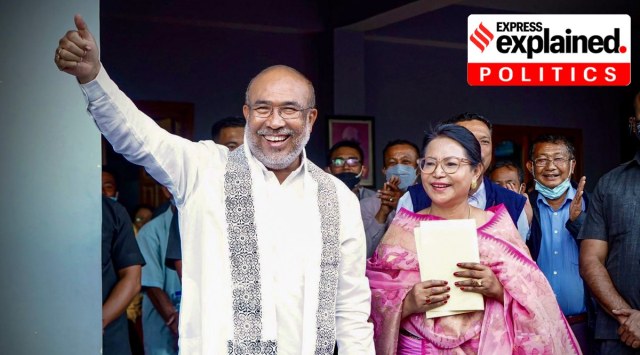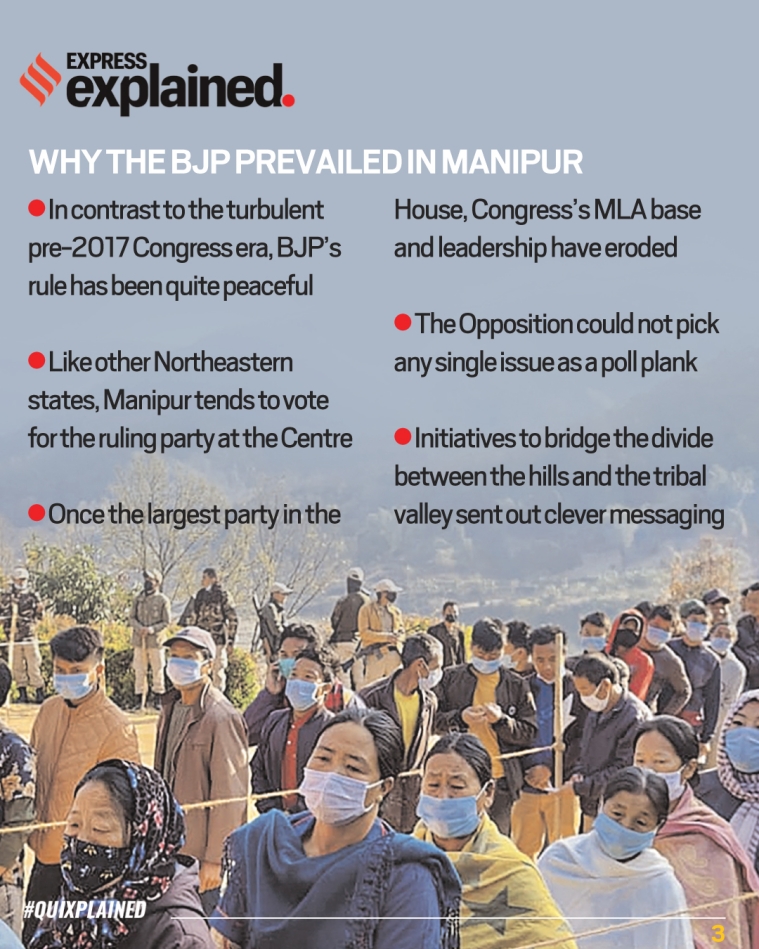Explained: Key takeaways from Manipur Assembly Election Results 2022
BJP's poll planks for peace, development, stability — a stark contrast to the tumultuous 15-year Congress regime under the Okram Ibobi Singh, which was marked by bandhs, blockades and a sharp rise in extra-judicial killings — seem to have struck a chord with voters.
 Chief Minister N. Biren Singh gestures after the party's victory in Assembly polls, outside of his residence, in Imphal, Thursday, March 10, 2022. (PTI Photo)
Chief Minister N. Biren Singh gestures after the party's victory in Assembly polls, outside of his residence, in Imphal, Thursday, March 10, 2022. (PTI Photo) Growth of BJP: From 21 seats in 2017, when it was behind the Congress (27) and needed to cobble up an alliance with smaller parties to form the government, the BJP is set to do so by itself now. Its poll planks for peace, development, stability — a stark contrast to the tumultuous 15-year Congress regime under the Okram Ibobi Singh, which was marked by bandhs, blockades and a sharp rise in extra-judicial killings — seem to have struck a chord with voters.
Power at the Centre: Like other small states of the Northeast region, Manipur often votes for the party that is in power at the Centre. With the BJP at the helm in New Delhi and commanding resources, voters saw the party as an easier and safer bet in 2022.
Decimation of Congress: Since 2017, when it was the single largest party with 27 seats, the Congress has gone through a difficult five years as its MLA base progressively eroded to 13. Marred by these defections and a lack of leadership, it was a particularly weakened Congress that contested in 2022, and won just five seats.
Rise of NPP: From four seats in 2017, Meghalaya CM Conrad Sangma’s National People’s Party (NPP) has won seven this time to emerge as a dark horse. It contested independently of the BJP, its partner in the government, pitching itself as a pan-Northeast party that is an alternative to the BJP and the Congress.
Kuki voice emerges: The home-grown Kuki People Alliance — recognised as a political party just two months ago, and formed to represent the interests of the Kuki tribe — has a surprising 100% strike rate, winning both seats it contested: Singhat and Saikul. Despite a diktat from the outlawed KNO and UPF to vote for the BJP, the little-known KPA managed to hold its own. Its victory is a significant development in Manipur’s political landscape, where tribal aspirations play a major role.
Newsletter | Click to get the day’s best explainers in your inbox
 Why the BJP won Manipur
Why the BJP won Manipur
- 01
- 02
- 03
- 04
- 05






































